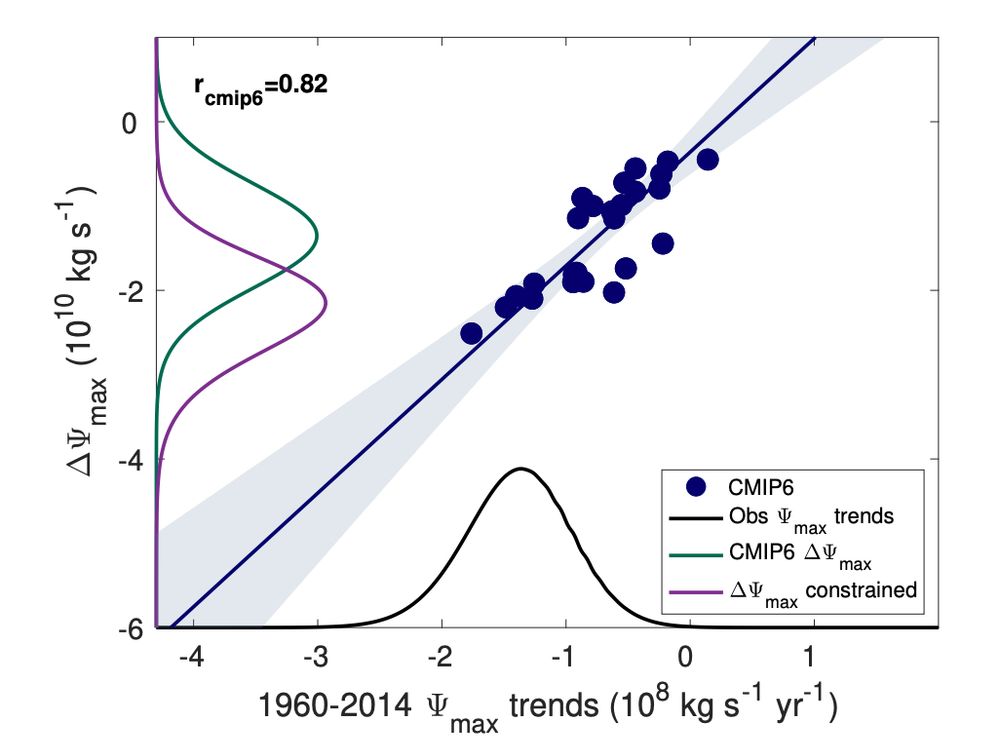6/ Our work offers a more refined prediction for subtropical precipitation changes by better constraining Hadley Cell weakening.
30.04.2025 17:24 — 👍 2 🔁 0 💬 1 📌 0

5) We show that the constraint work where the Hadley cell is more active - over Asia, Africa, & the Pacific.
30.04.2025 17:24 — 👍 1 🔁 0 💬 1 📌 0
4/ How we applied it: 1. We linked observable sea-level pressure changes to Hadley Cell strength. 2. Then, we related this constrained Hadley Cell weakening to projected increases in subtropical precipitation using the moisture budget.
30.04.2025 17:24 — 👍 0 🔁 0 💬 1 📌 0
3/ We used an 'emergent constraint' approach. This means we find relationships in climate models between an observable current climate feature (predictor) and a future climate projection (predictand). This helps refine future projections.
30.04.2025 17:24 — 👍 0 🔁 0 💬 1 📌 0
2/ Why is this important? Predicting future precipitation changes is tough, largely due to uncertainties in how atmospheric circulation will evolve. The Hadley Cell is a key player in tropical circulation, influencing rainfall patterns.
30.04.2025 17:24 — 👍 1 🔁 0 💬 1 📌 0

This is my first post in bsky!
1/ New Nature Climate Change paper - main results: 1. The Northern Hadley circulation weakening will likely be larger than predicted. 2. This leads to a greater increase in subtropical precipitation.
#ClimateScience
Paper link: www.nature.com/articles/s41...
30.04.2025 17:24 — 👍 5 🔁 0 💬 1 📌 0
Atmospheric dynamics, especially tropical & monsoons; UC Berkeley faculty
Director of Climate Simulation Research at NVIDIA and Professor of Earth System Sciences at UC Irvine. Let’s make better use of modern AI and HPC, improve the Earth simulation technology stack, and better understand cloud climate feedbacks.
Climate scientist working at NASA/JPL and lover of truth. Arrested for defending Earth. Opinions mine.
Scientific ML, ML theory, ML for climate, fluids, dynamical systems. Asst. Prof of Applied Math at UCSC. https://sites.google.com/view/ashesh6810/home
Professor @Columbia University, Director of @LEAPstc NSF Science and Technology Center, Working on #climate, #water and #ecology, born at 335ppm, views my own
Professor of climate science + applied math, University of Chicago @UChicago. AI for Climate Initiative (AICE). Extreme weather, scientific ML, climate change & turbulence.
Professor in Meteorology and Computer Science, Director of the NSF AI Institute for Research on Trustworthy AI in Weather, Climate, and Coastal Oceanography (AI2ES), mom to @wrmf.bsky.social and @agileschnauzers.bsky.social
Climate scientist @UCSD using machine learning to improve our understanding of clouds and aerosols. 🏄♂️
Find out more about the Climate Analytics Lab here: https://climate-analytics-lab.github.io/
Climate scientist. NERC Research Fellow @UniofOxford, prev Schmidt AI in Science; PostDoc @MIT, PhD @UniofOxford. #JuliaLang, open source, low carbon, free education, vegan, 🗻+🚲+🛥️. Cars ruin cities. *354ppm he|him
Research Engineer at Google DeepMind; Building AI for climate change mitigation & adaptation; he/him
A scientific research team dedicated to using machine learning to improving our ability simulate the climate
Scientist and Startup Founder
Co-Founder and CEO @Earthmover
@pangeo_data steering council member
ex-Professor @Columbia @LamontEarth
Lecturer (Asst. Prof.) @ University of Reading in meteorology and math. & stats | Data assimilation, climate, ML, applied dynamical systems, predictability, inverse problems, climate politics
https://eviatarbach.com
Building AI climate models at Google. I also contribute to the scientific Python ecosystem, including Xarray, NumPy and JAX.
Opinions are my own, not my employer's.
Intergovernmental Panel on Climate Change
Professor | Climate Scientist | AI for Earth System Prediction
Mostly mentoring a group of postdocs at Stanford.
Senior Scientist at Gates Ventures.
climate / energy / etc
https://sustainablesolutions.stanford.edu/people/ken-caldeira
Posts imperfectly represent the views of my former self and not my employer.


